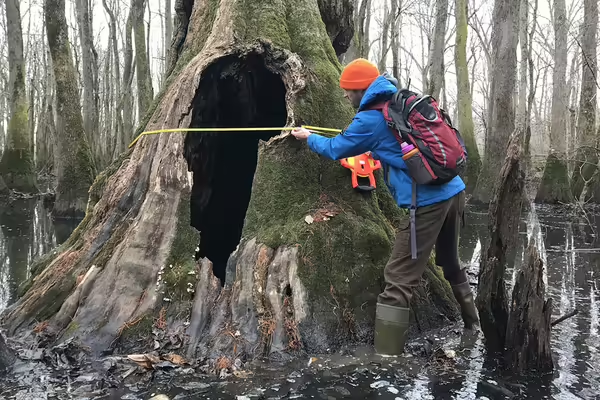
URBANA, Ill. – From the depths of the Shawnee National Forest to backyards in the suburbs of Chicago, Illinois’ biggest trees are branching out. For the first time, the state’s champion trees are now available as an interactive digital map.
“For more than 58 years, the Illinois Big Tree Register has inspired generations of big tree hunters who relish the opportunity to find and nominate the next champion tree,” says Jay Hayek, a University of Illinois Extension forestry specialist in the department of Natural Resources and Environmental Sciences. “The map is an exciting new way for us to continue to discover and recognize the value of our largest native tree species.”
NRES graduate and forestry technician Julia Allison developed the map, available at go.illinois.edu/championtrees, to give big tree hunters access to detailed information about each of the 88 champion trees listed on the Illinois Big Tree Register.
The map includes tree species details, GPS coordinates, measurements, and their resulting scores, as well as a list of the 10 largest trees on record to date. Big tree enthusiasts can use the map to track down Illinois’ top-ranked tree, a 122-foot tall Eastern Cottonwood in Ogle County, and the county with the most champion trees, Union County in Southern Illinois.
The register began in 1962 as a citizen-science outreach project to recognize the Prairie State’s largest native trees, and anyone with a tape measure can nominate a tree.
“The register is more than just the pursuit of the biggest tree of an individual species,” says Hayek, who coordinated the program since 2004. “It is a forestry awareness campaign that brings people, nature, and trees together in a fun, interactive, exciting, and competitive environment.”
Illinois forests have grown older and more mature over the past century. Since 1924, forest coverage has increased by 67%, Hayek says.
Research has shown that large, old trees grow faster and pull more carbon dioxide from the atmosphere than young trees. With more cracks, notches, and hollows, large trees provide shelter for many species of birds, mammals, and other wildlife. For homeowners, large trees increase property value, reduce energy bills, and add privacy.
Information on big tree eligibility, measurements, and the nomination process is available on the Forestry website at extension.illinois.edu/forestry/big-tree-register.
SOURCE: Jay Hayek, Extension Forestry Specialist
WRITER: Emily Steele, Media Communications Coordinator